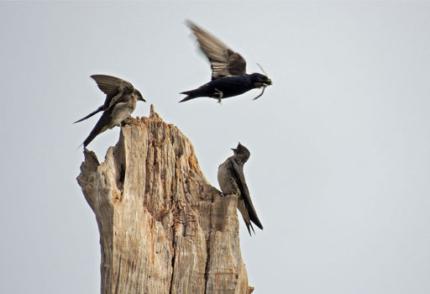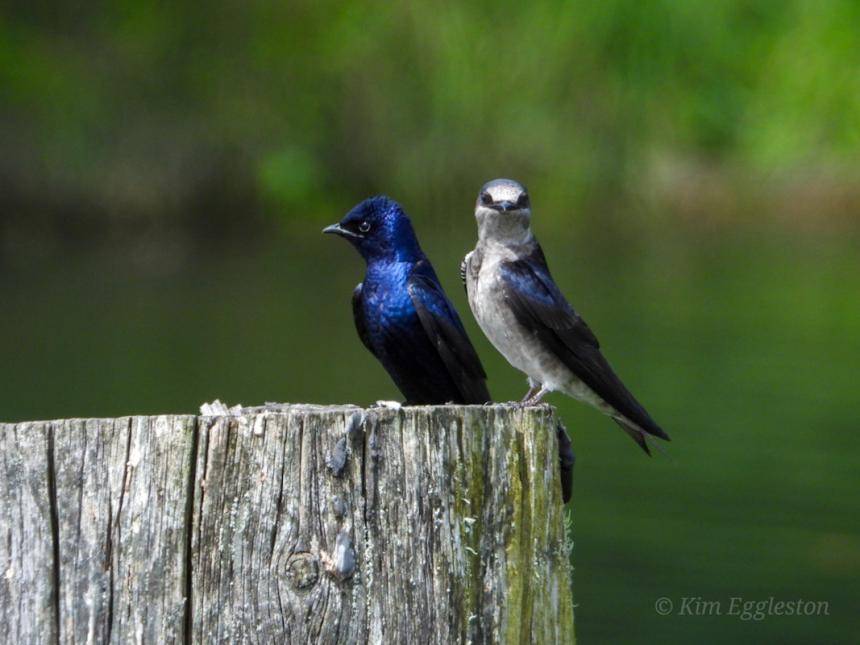Low-
Moderate
The purple martin found in Washington and elsewhere in western North America belongs to the subspecies Progne subis arboricola. The purple martin population in Washington is low and stable and possibly increasing. The population is largely dependent on humans to provide nest structures. Consequently, persistence of the population likely requires ongoing human intervention, such as erecting and maintaining nest structures.
Description and Range
Physical description
The purple martin is the largest swallow in North America and one of the largest in the world. They have broad chests, short forked tails, and long tapered wings with a span of 15 to 16 inches. Sized between a sparrow and a robin, both sexes weigh about 1.6 to 2.1 ounces and are between seven to nine inches long. Males are an iridescent dark blue-purple with brown-black wings. Females and juveniles are duller with a whitish lower belly, and gray on the beard and chest.
Ecology and life history
The primary purple martin nesting and foraging habitat in Washington is open land near water. They can be found in developed areas, along waterfronts, and in fields, wetlands, and clearings.

Purple martins feed on insects they catch in the air. They fly higher than other swallows, often exceeding 150 feet off the ground. Typical airborne catches include flies, dragonflies, damselflies, butterflies, wasps, bees, and mayflies. They also feed on beetles, spiders, and grasshoppers. Purple martins use small bits of grit to assist them in digesting insect exoskeletons.
Purple martins are secondary cavity users. They line their nest cavity with green leaves before and during egg-laying. Most nests are situated in the marine environment, in cavities in pilings or nest structures attached to pilings. They nest less commonly at lakes and marshes, and rarely in snags or in uplands. In Washington, they nest almost exclusively in human-made nest structures, such as nest boxes and gourds. Females lay four to five eggs which are incubated for 15 to 18 days. The young leave the nest at 28 to 29 days, and are fed by the parents for several more days.
Geographic range
Purple martins are found throughout much of eastern North America and along the Pacific coast. The purple martin found in Washington and elsewhere in western North America belongs to the subspecies Progne subis arboricola. This subspecies is geographically separate and has been genetically isolated from the eastern Progne subis subis for 200,000 to 400,000 years. The entire population of the western subspecies is estimated at less than 5,000 breeding pairs.
In Washington, purple martins are found in much of the Puget trough, Grays Harbor, Willapa Bay, and the lower Columbia River, but are rare elsewhere. The birds gather in large groups in late summer before they migrate to the Neotropics for the winter. It is thought that their presence and abundance in Washington is facilitated by the availability of nests built by humans. The population in Washington is very small, conservatively estimated at about 600 breeding birds; however, an estimate of population size based on a comprehensive survey is lacking.
For range-wide distribution and conservation status of this species, check out NatureServe Explorer.
Climate vulnerability
Sensitivity to climate change
Low-
Moderate
Purple martins are sensitive to climate-driven changes in habitat and prey availability. Low temperature periods, particularly in conjunction with precipitation, limit foraging opportunities and are the largest contributor to purple martin mortality. Drought can also affect food availability. Warming temperatures are causing earlier spring insect availability peaks, but purple martins are long-distance migrants, and have not yet shown adaptive response in migration timing in response to earlier spring food availability, at least in eastern U.S. populations. This mismatch between spring arrival and peak food availability contributes to undermined reproductive success and mortality; further studies are needed to see if selective pressures will advance migration timing for this species.
Purple martins nest in both next boxes and snags in secondary cavities formed by woodpeckers in montane areas and the Pacific lowlands; high habitat specificity makes them more vulnerable to climate change, although increasing fire frequency may increase habitat in burned forests.
Exposure to climate change
Low
- Changes in precipitation
- Drought
- Increased temperatures (possibly)
Conservation
Conservation Threats and Actions Needed
A key conservation threat to the purple martin is a lack of reliable information on population size and trend. The available information suggests the species may more abundant in Washington now than compared to the early period of Euro-American settlement. Little is known about the level of impact of loss of nest cavity trees due to deforestation and shoreline development to purple martins in the state.
Other factors that may pose threats to purple martins include competition with house sparrows or European starlings for nest sites, poor maintenance of artificial nesting structures, and susceptibility of the species to adverse weather, migratory and overwintering hazards, and insecticides.
A conservation action needed to address a lack of data is to develop a comprehensive and scientifically robust effort to monitor the population. The future stability or population increase of the purple martin is probably dependent on continued human intervention to maintain nest boxes and to ensure there is an availability of shoreline pilings, so replacement of older pilings lost to decay or removed due to pollution from creosote should be encouraged.
Our Conservation Efforts
WDFW helped co-found the Western Purple Mountain Working Group that meets annually to discuss new information, such as results of nest box monitoring; WDFW continues to actively participate. Nest box programs have been very successful in Washington and throughout the Salish Sea region.
